 W
WA 21-gun salute is the most commonly recognized of the customary gun salutes that are performed by the firing of cannons or artillery as a military honor. As naval customs evolved, 21 guns came to be fired for heads of state, or in exceptional circumstances for heads of government, with the number decreasing with the rank of the recipient of the honor. While the 21-gun salute is the most commonly recognized, the number of rounds fired in any given salute will vary depending on the conditions. Circumstances affecting these variations include the particular occasion and, in the case of military and state funerals, the branch of service, and rank of the person to whom honors are being rendered.
 W
WThe Fallen Soldier Battle Cross, Battlefield Cross or Battle Cross is a symbolic replacement of a cross, or marker appropriate to an individual service-member's religion, on the battlefield or at the base camp for a soldier who has been killed. It is made up of the soldier's rifle stuck into the ground or into the soldier's boots, with helmet on top. Dog tags are sometimes placed on the rifle, and the boots of the dead soldier can be placed next to the rifle. The purpose is to show honor and respect for the dead at the battle site. The practice started during or prior to the American Civil War, as a means of identifying the bodies on the battleground before removal. Today, it is a means of showing respect for the dead amongst the still living members of the troop. It is commonly seen in the field or base camp after a battle, especially among American troops in Afghanistan or Iraq. While it is used less today as a means of identification, it still serves as a method of mourning among the living, as attending the funeral is not always possible for soldiers still in combat.
 W
WBeating Retreat is a military ceremony dating to 17th-century England and was first used to recall nearby patrolling units to their castle.
 W
WA change of command is a military tradition that represents a formal transfer of authority and responsibility for a unit from one commanding or flag officer to another. The passing of colors, standards, or ensigns from an outgoing commander to an incoming one ensures that the unit and its soldiers is never without official leadership, a continuation of trust, and also signifies an allegiance of soldiers to their unit's commander.
 W
WA "clean sweep" for a naval vessel refers to having "swept the enemy from the seas," a completely successful mission. It is traditionally indicated by hanging a broom from a mast or lashing it to the periscope of a submarine.
 W
WThe Culture of the Russian Armed Forces is widely varied, but unique amongst the branches of the armed forces, and shared with the other uniformed organizations within Russia. Military culture is the most important component of military life. The major cultural events held by the Russian military are primarily aimed at strengthening esprit de corps as well as advancing the historical traditions of the Armed Forces of Russia. The Ministry of Defence of Russia regularly holds cultural events at various levels. The central cultural institutions of the Ministry of Defense of the Russian Federation are actively working in all military districts.
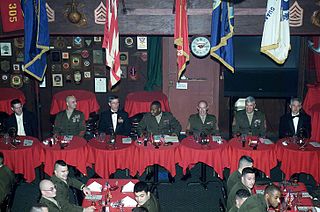 W
WDining in is a formal military ceremony for members of a company or other unit, which includes a dinner, drinking, and other events to foster camaraderie and esprit de corps.
 W
WThe District of Columbia Army National Guard (DCARNG) Honor Guard, is the Army National Guard's official Honor Guard program for the District of Columbia. The mission of the DCARNG Honor Guard is to provide military funeral honors (MFH) to qualifying veterans and participate in ceremonial and special events. Based on the mission and support needed, selected members of the Air National Guard's Honor Guard program are required to work jointly with the DCARNG to support missions that fall under the DCNG as a whole. The DCARNG Honor Guard program is assigned to the District of Columbia National Guard (DCNG) Joint Force Headquarters (JFHQ) Command.
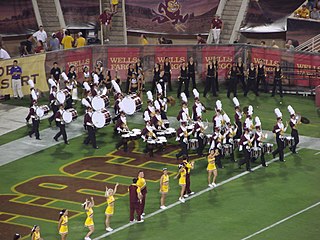 W
WIn music, a drum cadence or street beat is a work played exclusively by the percussion section of a modern marching band. It is stylistically descended from early military marches, and related to military cadences, as both are a means of providing a beat while marching. Usually, each instrument will have a part that mimics a specific drum or drums on a drum set to create a sound similar to a drum beat.
 W
WA military parade is a formation of soldiers whose movement is restricted by close-order manoeuvering known as drilling or marching. The military parade is now almost entirely ceremonial, though soldiers from time immemorial up until the late 19th century fought in formation. Massed parades may also hold a role for propaganda purposes, being used to exhibit the apparent military strength of one's nation.
 W
WA feu de joie is a form of formal celebratory gunfire consisting of a celebratory rifle salute, described as a "running fire of guns." As soldiers fire into the air sequentially in rapid succession, the cascade of blank rounds produces a characteristic "rat-tat-tat" effect. It is used on rare landmark occasions of national rejoicing. During the 18th and 19th centuries, a feu de joie has celebrated a military victory or birthday. In recent years, it has marked, in Royal presence, the 80th Birthday and Diamond Jubilee of Queen Elizabeth II, as well as the Royal Air Force Centenary. Feux de joie also mark annual national or army days in, e.g., Canada, Malta, Nepal and Singapore.
 W
WA flypast is a ceremonial or honorific flight by a group of aircraft or a single aircraft. The term flypast is used in the United Kingdom and the Commonwealth. In the United States, the terms flyover and flyby are used.
 W
WFoot drill is a part of the training regimen of organized military and paramilitary elements worldwide. "Foot drill" or "Drill" stems from time since antiquity when soldiers would march into battle, be expected to gather in a formation, and react to words of command from their commanders once the battle commenced. Much of the drill done today is either ceremonial, or implemented as a core part of training in the Armed Forces. Military discipline is enhanced by drill, as it requires instant obedience to commands and synchronized completion of said commands with the others in the unit.
 W
WThe goose step is a special marching step performed on formal military parades and other ceremonies. While marching in parade formation, troops swing their legs in unison off the ground while keeping each leg rigidly straight.
 W
WThe Großer Wachaufzug was a military ceremony and guard mounting in Berlin, the capital Germany, held on certain occasions at the Neue Wache. The building has been the center of guard duties performed since 1931.
 W
WGuard mounting, changing the guard, or the changing of the guard, is a formal ceremony in which sentries performing ceremonial guard duties at important institutions are relieved by a new batch of sentries. The ceremonies are often elaborate and precisely choreographed. They originated with peacetime and battlefield military drills introduced to enhance unit cohesion and effectiveness in the late 17th and early 18th centuries.
 W
WA guard of honour (GB), also honor guard (US), also ceremonial guard, is a guard, usually military in nature, appointed to receive or guard a head of state or other dignitaries, the fallen in war, or to attend at state ceremonials, especially funerals. In military weddings, especially those of commissioned officers, a guard, composed usually of service members of the same branch, form the Saber arch. In principle any military unit could act as a guard of honour. However, in some countries certain units are specially designated to serve as a guard of honour, as well as other public duties.
 W
WMarching refers to the organized, uniformed, steady walking forward in either rhythmic or route-step time; and, typically, it refers to overland movements on foot of military troops and units under field orders. It is a major part of military basic training in most countries and usually involves a system of drill commands. A soldier learning to march to drum cadences, martial music and shouted commands is considered an essential element of teaching military discipline.
 W
WA memorial bracelet is a cuff style bracelet worn around the wrist. The term memorial bracelet was coined by Rob Tacy in October, 2001 when he launched the MemorialBracelets.com website. The bracelet is made of either aluminium, stainless steel, or leather and engraved with the name of a person who died or an event. These bracelets are worn as a way to show support, to remember a victim or hero of terrorism or war, to make people aware of a person that has died and the reason for the death, to commemorate an event such as the September 11 attacks on the United States, or to support and remember American servicepeople who were POWs or MIA.
 W
WIn the armed services, a military cadence or cadence call is a traditional call-and-response work song sung by military personnel while running or marching. In the United States, these cadences are sometimes called jody calls or jodies, after Jody, a recurring character who figures in some traditional cadences; Jody refers to the man with whom a serviceman's wife/girlfriend cheats while he is deployed.
 W
WA military funeral is a memorial or burial rite given by a country's military for a soldier, sailor, marine or airman who died in battle, a veteran, or other prominent military figures or heads of state. A military funeral may feature guards of honor, the firing of volley shots as a salute, drumming and other military elements, with a flag draping over the coffin.
 W
WA military funeral in the United States is a memorial or burial rite conducted by the United States Armed Forces for a Soldier, Marine, Sailor, Coast Guardsman, or Airman who died in battle, a veteran, or other prominent military figures or a president. A military funeral may feature guards of honor, the firing of volley shots as a salute, drumming and other military elements, with a flag draping over the coffin.
 W
WMilitary mascot refers to a pet animal maintained by a military unit as a mascot for ceremonial purposes or as an emblem of that unit.
 W
WMilitary rites are honors presented at a funeral for a member of a military or police force. These rites, which are performed (usually) at the burial, include the firing of rifles, presenting of a flag and or bugle calls. In Australia and New Zealand a Poppy Service is often held for members of the Armed Forces. This includes a short reading by a member of the Returned Services League of Australia or, in New Zealand, the Returned Services Association, the laying of red poppies on the coffin by all present, the playing of the Last Post, Reveille, and recitation of the Ode of Remembrance.
 W
WThe military saints, warrior saints and soldier saints are patron saints, martyrs and other saints associated with the military. They were originally composed of the Early Christians who were soldiers in the Roman Army during the persecution of Christians, especially the Diocletian persecution of AD 303–313.
 W
WMilitary step or march is a regular, ordered and synchronized walking of military formations.
 W
WMilitary tradition is the practices associated with the military or soldiers such as the styles of military uniform, drill, or the music of a military unit.
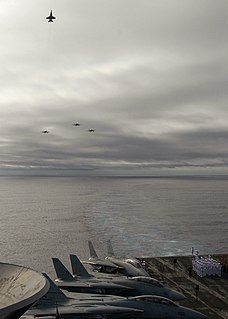 W
WThe missing man formation is an aerial salute performed as part of a flypast of aircraft at a funeral or memorial event, typically in memory of a fallen pilot, a well-known military service member or veteran, or a well-known political figure.
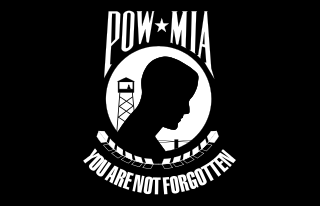 W
WA missing man table, also known as a fallen comrade table, is a ceremony and memorial that is set up in military dining facilities of the United States Armed Forces and during official dining functions, in honor of fallen, missing, or imprisoned military service members. The table serves as the focal point of ceremonial remembrance, originally growing out of US concern of the Vietnam War POW/MIA issue.
 W
WA naval tradition is a tradition that is, or has been, observed in one or more navies.
 W
WA military parade is a formation of soldiers whose movement is restricted by close-order manoeuvering known as drilling or marching. The military parade is now almost entirely ceremonial, though soldiers from time immemorial up until the late 19th century fought in formation. Massed parades may also hold a role for propaganda purposes, being used to exhibit the apparent military strength of one's nation.
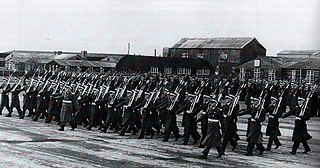 W
WPassing out is the completion of a course by military or other service personnel or the graduation from a college, largely in Commonwealth nations. Soldiers sometimes take part in a passing out parade upon completion of a basic training course. The military parade during the passing out also consists of military bands and other displays of synchronization discipline such as acrobatics.
 W
WPiano burning is the act of setting on fire an acoustic piano, most commonly an upright, as either a ceremony or a form of performance art. Although piano burning ceremonies are now popular in the Royal Air Force, Royal Canadian Air Force and the United States Air Force, there is little or no evidence to suggest that descriptions of its origin have any historical authenticity. According to one version of its origin, pianos were set alight by RAF pilots to avoid piano lessons aimed at improving their dexterity and general level of culture. Another version is that piano burning began in World War II in remembrance of fallen RAF pilots. Several contemporary musicians, including Annea Lockwood, Yōsuke Yamashita, and Diego Stocco, have composed for and performed on pianos which have been deliberately set alight. A burning piano was also the centrepiece of Douglas Gordon's 2012 video installation, The End of Civilisation.
 W
WThe Presentation of Colours is a ceremony that marks an anniversary or event in the history of a particular regiment. This involves the presentation of a new version of the regimental colour to a regiment or equivalent formation in the armed forces. This is a traditional ceremony that was pioneered by the British Armed Forces, and is today used in most Commonwealth countries.
 W
WThe President's Colour Award is the highest honor that can be bestowed upon any military unit of India. It is also known as ′Nishaan′ which is an emblem that will be worn by all unit officers on the left-hand sleeve of their uniform.
 W
WThe quarter guard is a small detachment of troops that can be used as a ceremonial guard which may be mounted at the entrance of a military unit to pay compliments as required. A quarter guard is to consist of one non-commissioned officer and six or eight other ranks formed up in two ranks. It is technically a minuscule guard of honour.
 W
WA riderless horse is a single horse, without a rider, and with boots reversed in the stirrups, which sometimes accompanies a funeral procession. The horse follows the caisson carrying the casket. A riderless horse can also be featured in military parades to symbolize fallen soldiers. In Australia for example, it is traditional for a riderless horse known as the 'Lone Charger' to lead the annual Anzac Day marches.
 W
WA saber arch is a wedding tradition in which sabers or swords are used to salute a newly married couple. The bride and groom pass under an honorary arch of sabers, typically when exiting the building in which the wedding ceremony took place. The tradition is in use worldwide.
 W
WA salute is a gesture or other action used to display respect. When saluting a person, as distinct from a flag or a National Anthem or other symbolic melody, the gaze must be towards that person, also when returning a salute. Thus, the respectable salute includes a greeting. Not looking at the person, as with most gestured greetings, is likely to be interpreted as disrespect or an eye deficiency. Salutes are primarily associated with armed forces and law enforcement, but other organizations, such as girl guides, and boy scouts and other civilians also use salutes.
 W
WA steel beach picnic or steel beach party is a tradition in the United States Navy. Such events are often department-sponsored barbecues held on the deck of the ship, hence the name "steel beach". They are often held on the flight deck or in a large hangar bay for carriers, much like a day at the beach with volleyball and other sporting events.
 W
WThe three-volley salute is a ceremonial act performed at military funerals and sometimes also police funerals. The custom originates from the European dynastic wars, in which the fighting ceased so that the dead and wounded could be removed. After this was accomplished, three shots were fired into the air to signal that the battle could resume.
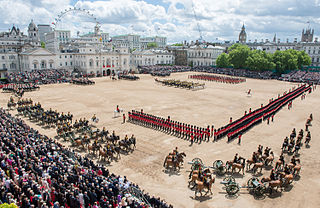 W
WTrooping the Colour is a ceremony performed by regiments of the British and Commonwealth armies. It has been a tradition of British infantry regiments since the 17th century, although its roots go back much earlier. On the battlefield, a regiment's colours, or flags, were used as rallying points. Consequently, regiments would have their ensigns slowly march with their colours between the ranks to enable soldiers to recognise their regiments' colours.
 W
W"True Scotsman" is a humorous term used in Scotland for a man wearing a kilt without undergarments. Though the tradition originated in the military, it has entered Scottish lore as a rite, an expression of light-hearted curiosity about the custom, and even as a subversive gesture.
 W
WUnited States military music customs are the traditional, regulatory, and statutory provisions that guide performances by United States military bands during drill and ceremony and state occasions.
 W
WThe Jolly Roger is a symbol that has been used by submarines, primarily those of the Royal Navy Submarine Service and its predecessors. The practice came about during World War I: remembering comments by First Sea Lord Admiral Sir Arthur Wilson, who complained that submarines were "underhanded, unfair, and damned un-English" and that personnel should be hanged as pirates, Lieutenant Commander Max Horton began flying the flag after returning from successful patrols. Initially, Horton's submarine HMS E9 flew an additional flag after each successful patrol, but when there was no room for more, the practice was changed to a single large flag, onto which symbols indicating the submarine's achievements were sewn.
 W
WVictory Day Parades are common military parades that are held on 9 May in various post-soviet nations, primarily Russia, Kazakhstan, Belarus, and formerly Ukraine. They are usually held to honor the traditional Victory Day holiday. In 2015, the Ukrainian government had renamed the holiday as "Victory Day over Nazism in World War II" as part of decommunization laws. However, even after the change, a vast amount of the populace still honors Ukrainian-Soviet troops who fought in World War II with traditional Victory Day parades.
 W
WA wreath is an assortment of flowers, leaves, fruits, twigs, or various materials that is constructed to form a ring.